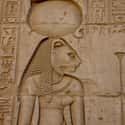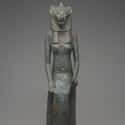-
(#1) Egyptians Shaved Their Eyebrows When Their Cats Died
In ancient Egypt, the reverence for cats was extended into their death, with family members showing the same respect as they would for a human funeral. Family members of the cat would even shave their eyebrows to signify their loss. Once their eyebrows grew back, their period of mourning was over. -
(#2) Persians Once Used Cats To Make The Egyptian Army Surrender
Cats were so highly revered by the Egyptians that the Persians took advantage of this. According to Ancient History Encyclopedia, "The greatest example of Egyptian devotion to the cat, however, comes from the Battle of Pelusium (525 BCE) in which Cambyses II of Persia defeated the forces of the Egyptian Pharaoh Psametik III to conquer Egypt."
Cambyses ordered his men to capture a bunch of cats and release them on the battlefield outside Pelusium; rather than risk harming the sacred cats, the Egyptians quickly surrendered to the Persian army. -

(#3) Mesopotamians Were The First To Domesticate Cats
Ancient Mesopotamians (like ancient Egyptians) were one of the earliest societies dependent on agriculture. The enemies of an agricultural-based society were creatures who ate their crops - namely mice, snakes, and rats. Historians believe that once Mesopotamians figured out that wild cats preyed on these scavengers, they started encouraging them to patrol their property by leaving food for them. Over time, cats became more accustomed to humans and came to depend on them for a steady food supply. Eventually, Mesopotamians started breeding cats and they slowly became domesticated. -

(#4) There Was An Annual Cat Festival In Ancient Egypt
This festival centered around the temple of Bast in the city of Bubastis, reportedly one of the most magnificent temples ever erected in ancient Egypt. People traveled from all over Egypt for the festival, which was a joyous celebration of Bast. They gathered to worship, sing, dance, and drink together. -
(#5) Ancient Egyptians Killed Cat-Killers
Record show that as early as 450 BCE, the punishment for killing a cat, even accidentally, was death. Diodorus Siculus, a Greek historian, wrote, "Whoever kills a cat in Egypt is condemned to death, whether he committed this crime deliberately or not. An unfortunate Roman, who accidentally killed a cat, could not be saved, either by King Ptolemy of Egypt or by the fear which Rome inspired." -

(#6) Egyptians Worshipped Cats Because They're Great Protectors
In ancient Egypt, there was a constant threat of scorpions, asps (snakes), rats, and other creatures that would sting or bite, and cats would hunt them all and protect their owner's home. Many Egyptian families depended upon cats to protect them, especially if they had babies or young children. -
(#7) Mafdet Was A Feline-Like Egyptian Goddess
Mafdet was a protector and was nearly always depicted as a woman with a cat's head, or occasionally as a cat with a woman's head. She is the earliest known feline-like goddess. -
(#8) Ovinnik Protected Crops In Poland
In Slavic mythology, Ovinnik was the keeper of the barn (otherwise known as a barn cat) and not only protected crops from being eaten but also protected livestock from predators. Ovinnik also upheld justice, burning down the homes of those who had committed acts of evil.
-
(#9) A Chinese Cat God Protected Crops
Li Shou protected crops from being eaten by mice and rats, not unlike his cat counterparts who were so revered in Egypt. There's even a fun Chinese myth about how Li Shou was originally given responsibility for world affairs but just wanted to nap, so the task was turned over to humans instead.
-
(#10) Ancient Egyptians Believed Cat Dreams Brought Good Luck
Seeing a feline in your dreams was especially fortuitous in ancient Egypt - this primarily indicated a good harvest (the larger the cat, the larger the harvest), but also good fortune in general. -

(#11) The Egyptian Goddess Bastet Could Transform Into A Cat
As Mafdet's popularity declined, Egyptians began worshipping a new goddess: Bastet. They believed that she watched the world and guarded Egypt against invasion. Since she could transform into a cat and had many similarities to cats, they believed that cats were her physical manifestation. Bastet protected Egypt; cats, on a smaller scale, protected the home. -

(#12) Cats Were Mummified In Egypt
Since cats were sacred to the goddess Bastet, they were either given as an offering to the feline goddess (by being buried on temple grounds) or mummified and buried alongside their humans, exactly as a valued member of the family would be. Cats would be given provisions for the afterlife just like humans. Cats were typically given a bowl of milk and some mummified mice to accompany them on their journey across the river Styx. -

(#13) Egyptians Protected Cats From Fires
Herodotus (an ancient historian) claimed that whenever there was a house fire in Egypt, the standard response was that the men from the house would stand guard outside to make sure no cats ran toward the building, lest they come to harm. They would also run into a burning building just to save a cat that was trapped inside. -
(#14) Ra Once Took The Form Of A Cat
Yet another Egyptian deity is linked to cats - in the Book of the Dead, an ancient Egyptian text, Ra, the Egyptian sun god, takes on the form of a cat called Mau in order to defeat the serpent Apep. -
(#15) Even Regular Cats Were Worshiped In Ancient Egypt
There is an inscription in the Valley of the Kings (where all noblemen were buried) that celebrates the common cat. It states, "You are the Great Cat, the avenger of the gods, and the judge of words, and the president of the sovereign chiefs and the governor of the holy Circle; you are indeed the Great Cat." -

(#16) The Egyptian Army Took Back Stolen Cats
Court records from around 450 BCE indicate that it was illegal to export cats to neighboring countries, making cat smuggling a thriving (yet risky!) trade. Egyptian court records also indicate that small armies were sent out to retrieve stolen or smuggled cats.
-

(#17) Egyptians Thought Cats Brought Good Luck
Since they were an extension of the goddess Bast, cats in the home were thought to bring good luck, protection, and even fertility.
-
(#18) Egyptians Draped Their Cats In Jewels
Cats were seen as valued demi-gods who protected the family and were a living representation of the goddess Bast, so they were afforded luxuries whenever possible. The higher the status, the bigger the jeweled collar. -
(#19) Cat Worship In Egypt Declined Because Of Persian Rulers
After Persians began ruling Egypt in 525 BCE, the cult of Bast significantly declined. Persian rulers destroyed Bubastis and temples dedicated to Bast in 350 BCE. However, cats remained an integral part of the family, because of their protection skills against snakes and scorpions.
But reverence for cats didn't completely go the way of the Dodo. Cats also have a special place in Islam, being a beloved pet of the Prophet Mohammed. -
(#20) Ancient Greeks Believed Artemis Transformed Into A Cat
Even ancient Greece got in on the act of cat worship. The goddess of the hunt, Artemis, once morphed into a cat so she could successfully flee from the monster Typhon. She extended her favor to cats after her escape.
New Random Displays Display All By Ranking
About This Tool
In ancient civilizations, the history of cat worship in ancient Egypt is the most noticeable. In Egyptian mythology, the sun god was once incarnate as a cat, so people regard cats as the incarnation of the gods. The Sphinx is the best proof. With the popularity of domestic cats in Egypt, the image of cats has gradually changed from the god of war to the patron saint, and the cat still has the symbolic meaning of the defender of the pharaoh.
Numerous historical sites and documents have recorded the fact that the ancient Egyptian people worshiped cats. The random tool displays 20 historical relics that reflect some odd things about cat worship.
Our data comes from Ranker, If you want to participate in the ranking of items displayed on this page, please click here.





















